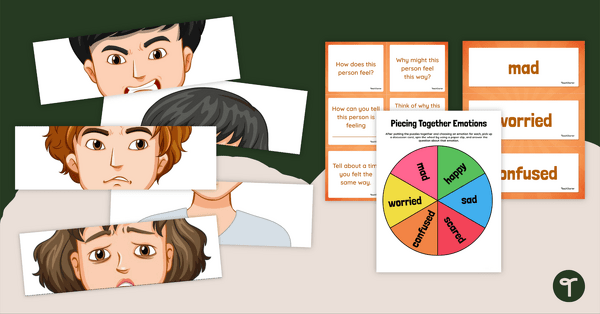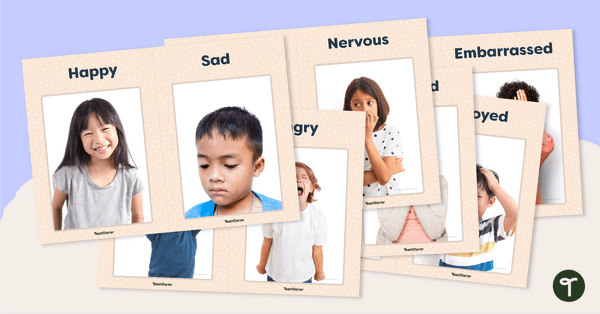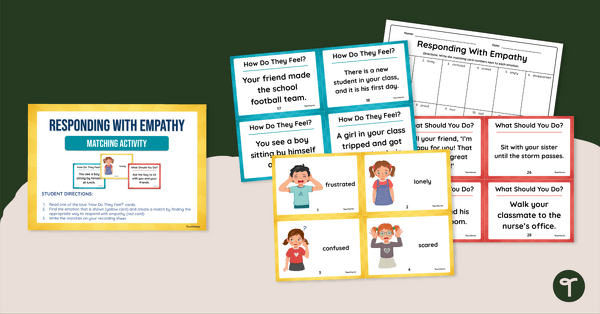Empathy Teaching Resources
Explore empathy activities for kids and more teacher resources for the primary classroom, all created by teachers for teachers like you.
This collection of activities, worksheets, classroom posters and more is designed to help kids build their social awareness core competency and help you create a more positive and inclusive classroom environment.
Are you looking for help to teach empathy this school year? Read on for a primer from our teacher team, including an empathy definition for kids, empathy examples that kids can understand, and more.
What Is Empathy? A Kid-Friendly Definition
Let's start with how you can define empathy for your students. While they're likely familiar with related concepts like kindness and compassion, empathy can be a bit harder to grasp — especially for early years students.
Here's a kid-friendly definition that our teacher team uses with kids:
Empathy is when you try to understand how someone else is feeling and show you really care about their feelings. It's like putting yourself in their shoes and imagining what it would be like to be them.
When you show empathy, you also show kindness, and you try to help and support your friends and others when they need it.

What Is the Best Way to Teach Empathy?
We're often asked what the 'best way' to teach a particular topic is, and we're going to be very frank. There is no best way!
We recognise that each teacher, classroom and student is different. What's best for one classroom may not be best for the next.
With that said, there are some tips and strategies that we have honed over the years that you might find helpful for incorporating empathy into your overall social awareness lesson planning.
- Model Empathy — It all starts with you! Demonstrate to your students how to show understanding, compassion and kindness with your own actions towards your students and colleagues.
- Mine Personal Experiences — You don't have to reveal all the details of your personal life to your students (or really any of your personal life if you don't want to). But when you're reading books aloud to students, it can be helpful to use situations you've read about as jumping-off points to say, 'I know how she feels; that used to happen to me all the time…' and share an anecdote (even if it's a bit more of an extrapolation of events). Open the discussion to the whole class to discuss events where empathy was or was not shown.
- Assign Empathy Journals — Encourage students to fill out empathy journals where they record times during the day that they have shown understanding, compassion and kindness towards others. Keeping an Empathy Journal is also a great opportunity for your students to reflect upon times when they did not show empathy and to consider how they might show more understanding in the future.
- Listen Actively to Your Students —Avoid passively listening while waiting for an opportunity to interject and speak. Instead, fully concentrate and understand what is being said.
- Teach Empathy Explicitly — Set goals, share objectives and dedicate time to teaching and learning the skill of empathy.
Our Teacher Team's Favourite Empathy Activities for Kids
Are you looking for more specific activities to teach empathy to kids? Here are a few favourites from our teacher team! You may find these are particularly helpful activities to use to reduce bullying incidents in your classroom.
Apples and Empathy
Supplies
- 2 apples that look about the same
Instructions
- After purchasing your apples, bang one repeatedly against a hard surface the night or morning before you bring it into class. You don't have to overdo it. The goal is not to break the skin — just bruise the insides.
- Present the two apples to the whole class.
- Take the apple that was not banged against the hard surface, and walk around the classroom, presenting it to each student. Ask each student to say something kind/compliment the apple.
- Take the other apple (the one with the bruised insides), and carry it around the classroom.
- This time, have every student say something mean to that apple.
- Return to the front of the classroom, and cut both apples in half, revealing a nice, healthy inside for the one that received kind words and an ugly, bruised, brown inside for the one that received only unkind words.
- Use this to lead a class discussion about how our words can affect others.

The Baggage Empathy Activity
Supplies
- An empty shopping bag
- Slips of plain paper
- Pencils
Instructions
- Present the bag to your students, and introduce the concept of 'baggage,' the hurtful thoughts and feelings we carry around that others may or may not know about.
- Hand out a blank slip of paper to each student in the classroom.
- Encourage students to write down at least one item of 'baggage' that is weighing on them. Make sure to let them know that they do not have to put their names on their paper.
- Have students scrunch up the piece of paper into a ball and drop it into the shopping bag.
- One by one, remove each piece of paper from the bag and read it out loud. (Alternative idea: Have students come up one by one, select a piece of paper and read it out loud.)
- Once all the pieces of paper are read out loud, ask students to share how they feel after the exercise.
- Free Plan

Empathy Word Search
Introduce or review vocabulary terms related to empathy with this free word search worksheet.
- Free Plan

Feelings and Emotions Match-Up Activity
Help students to recognise and identify their feelings and emotions with this interactive match-up activity.
- Plus Plan

Oral Language Activities
Share these oral language activities with your students to help them practise listening to others, expressing opinions, receiving instructions, and more!
- Plus Plan

Piecing Together Emotions – Puzzle Activity
Guide your students to identify the feelings and emotions of others with this social emotional learning puzzle activity.
- Plus Plan

Empathy vs. Sympathy Reading Comprehension Worksheet
Challenge your students to learn the differences between empathy and sympathy with this reading comprehension worksheet.
- Free Plan

Recognising Feelings Flashcards
Improve your students' emotional literacy with this set of feelings flashcards.
- Plus Plan

Choose Empathy Teaching Slides & Note Guide
Help your students understand the difference between empathy and sympathy while learning how to be empathetic with this set of teaching slides and note guide.
- Plus Plan

Showing Empathy Teaching Slides
Transform your classroom into a hub of empathy and kindness! Elevate your students’ social awareness with this set of SEL teaching slides.
- Plus Plan

Characteristics of Emotions - Posters
Help students learn the facial expressions and body cues that accompany the most common emotional states with this set of classroom display posters.
- Plus Plan

Showing Empathy Interactive Activity
Encourage your students to identify acts of empathy and determine the right thing to do in a given situation with an interactive activity designed for year 1 and 2 students.
- Plus Plan

A Walk in My Shoes – Empathy Task Cards
Use these empathy scenario cards with your students when teaching them about social awareness.
- Plus Plan

Showing Empathy Flipbook
Cultivate compassion in young minds! Download our printable empathy flipbook tailored for year 1 and 2 students.
- Plus Plan

Empathy Discussion Cards
Promote kindness and understanding in your classroom! Download our set of empathy discussion cards to engage your students in meaningful conversations.
- Plus Plan

Printable Empathy Games
Spark empathy in young hearts! Download our set of printable empathy games specially crafted for year 1 and 2 students.
- Plus Plan

What Would You Do? Empathy Board Game
Challenge your students to think about the feelings of others and how to appropriately respond with the empathy board game.
- Plus Plan

Everyday Empathy Interactive Game
Download this interactive game and help your students practise identifying emotions and understanding how others feel.
- Free Plan

Showing Empathy Mini-Book
Empower young minds and hearts with the gift of empathy! Download this free SEL mini-book designed for year 2 and 3 students.
- Plus Plan

Empathy Social Stories Interactive Activity
Help your students determine empathetic behaviours with this interactive game designed for year 1 and 2 students.
- Plus Plan

Empathy Worksheet Pack
Unlock a world of empathy with our SEL worksheet pack – download now and embark on a journey to nurture kindness and understanding with your students.
- Plus Plan

Caring for Others – Printable Empathy Book
Unlock the magic of empathy by giving your students a mini-book about how to connect, understand and make a difference through the simple act of caring.
- Plus Plan

Responding With Empathy Matching Activity
Guide your students to identify emotions in others and select appropriate ways to respond with empathy with this matching activity.
- Plus Plan

Empathy, Sympathy and Compassion Poster for the Classroom
Highlight the differences between empathy, sympathy and compassion with this printable poster.
- Plus Plan

Verbal and Nonverbal Communication Poster
Teach your young students the key to communication by starting with the basics — the difference between verbal and nonverbal communication methods.
- Plus Plan

Showing Compassion – Interactive Activity
Help students understand the importance of caring for others and how to appropriately respond with this interactive activity.
- Plus Plan

Worksheet and Poster for Empathy
Teach your students how to share the feelings of others with this worksheet and poster for empathy.
- Plus Plan

Emotions Worksheet Set
Help students understand different emotions with this set of five emotions worksheets.